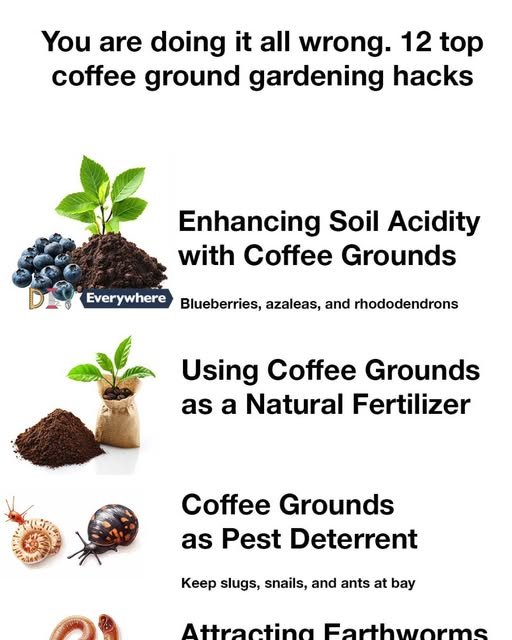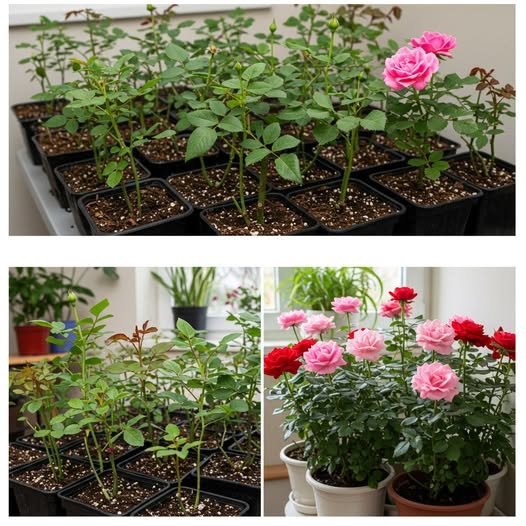Coffee grounds are often seen as waste, but they can be a gardener’s best friend. Rich in nutrients and organic matter, coffee grounds can enhance soil quality and promote plant growth. Many gardeners are unaware of the myriad ways coffee grounds can be utilized in the garden. This article will explore 12 top hacks for using coffee grounds effectively, ensuring you’re not just throwing away a valuable resource.
Understanding the Benefits of Coffee Grounds
Coffee grounds are a rich source of nitrogen, an essential nutrient for plant growth. They also contain other important minerals like potassium and phosphorus. Additionally, coffee grounds improve soil structure, increase water retention, and promote beneficial microbial activity. By understanding these benefits, gardeners can make informed decisions about incorporating coffee grounds into their gardening practices.
Hack 1: Enhancing Soil Acidity with Coffee Grounds
Certain plants, such as blueberries, azaleas, and rhododendrons, thrive in acidic soil. Coffee grounds can help increase soil acidity, making them ideal for these acid-loving plants. Simply sprinkle used coffee grounds around the base of these plants to gradually lower the pH of the soil.
Hack 2: Using Coffee Grounds as a Natural Fertilizer
Coffee grounds can be used as a slow-release fertilizer. They release nitrogen, potassium, and phosphorus over time, providing a steady supply of nutrients. To use coffee grounds as a fertilizer, mix them into the top layer of soil or add them to your compost pile to enhance its nutrient content.
Hack 3: Composting with Coffee Grounds for Richer Soil
Adding coffee grounds to your compost pile can accelerate the decomposition process. Coffee grounds are considered ‘green’ compost material, rich in nitrogen. They balance out ‘brown’ materials like leaves and straw, creating a nutrient-rich compost that can be used to enrich garden soil.
Hack 4: Coffee Grounds as a Pest Deterrent
Coffee grounds can act as a natural pest deterrent. Their texture and smell can keep slugs, snails, and ants at bay. Sprinkle coffee grounds around the perimeter of your garden or specific plants to create a barrier that pests are less likely to cross.
Hack 5: Improving Drainage with Coffee Grounds
Incorporating coffee grounds into heavy, clay soils can improve drainage. The grounds help break up compacted soil, allowing water to penetrate more easily. Mix coffee grounds into the soil to enhance its structure and prevent waterlogging.
Hack 6: Coffee Grounds for Mulching
Coffee grounds can be used as a mulch to retain moisture, suppress weeds, and regulate soil temperature. Spread a thin layer of coffee grounds around plants, ensuring not to pile them too thickly, as they can compact and form a barrier to water and air.
Hack 7: Attracting Earthworms with Coffee Grounds
Earthworms are beneficial for soil health, and they are attracted to coffee grounds. The grounds provide food for earthworms, which in turn aerate the soil and improve nutrient availability. By adding coffee grounds to your garden, you can encourage a healthy earthworm population.
Hack 8: Coffee Grounds for Fungal Disease Prevention
Coffee grounds contain natural antifungal properties that can help prevent fungal diseases in plants. When used as a mulch or incorporated into the soil, they can reduce the incidence of diseases like fusarium and verticillium wilt.
Hack 9: Creating a Balanced Coffee Ground Fertilizer Mix
To create a balanced fertilizer mix, combine coffee grounds with other organic materials like eggshells and banana peels. This mix provides a broader range of nutrients, including calcium and potassium, ensuring plants receive a well-rounded diet.
Hack 10: Coffee Grounds for Acid-Loving Plants
For plants that require acidic conditions, such as camellias and gardenias, coffee grounds can be a perfect addition. Regularly adding coffee grounds to the soil can help maintain the desired acidity levels, promoting healthy growth and vibrant blooms.
Hack 11: Coffee Grounds in Vermicomposting
Vermicomposting, or worm composting, benefits from the addition of coffee grounds. Worms are attracted to the grounds, which provide a rich source of nitrogen. Adding coffee grounds to a worm bin can enhance the composting process and produce nutrient-rich worm castings.
Hack 12: Coffee Grounds for Seed Starting
Coffee grounds can be used to create a seed starting mix. Their fine texture and nutrient content make them suitable for germinating seeds. Mix coffee grounds with sand or perlite to create a well-draining medium that supports seedling growth.
Conclusion: Maximizing the Benefits of Coffee Grounds in Your Garden
By incorporating coffee grounds into your gardening routine, you can enhance soil quality, promote plant health, and reduce waste. These 12 hacks demonstrate the versatility and benefits of coffee grounds, encouraging gardeners to rethink how they use this common byproduct. With a little creativity and knowledge, coffee grounds can become an invaluable tool in your gardening arsenal.



